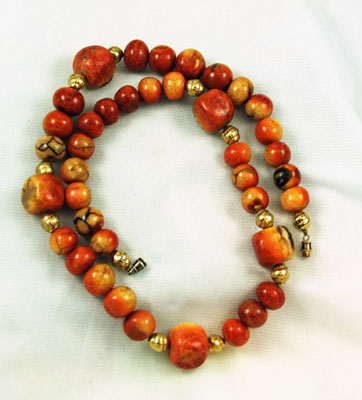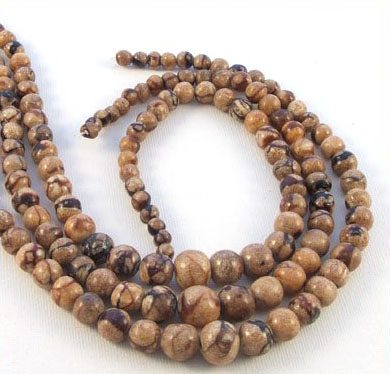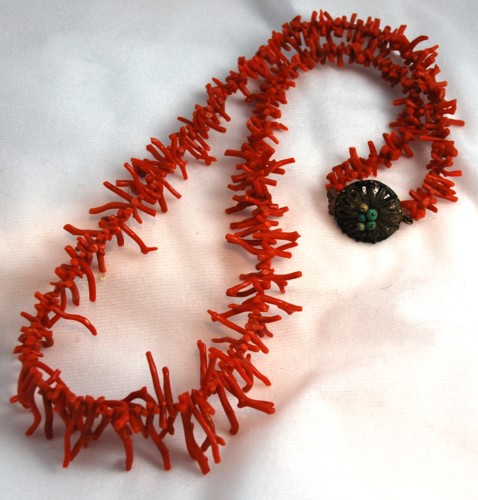
Coral Has Been Used For Centuries
Coral is a natural organic substance that has been considered a precious gem since prehistoric times. It has been valued in jewelry making for thousands of years. It has long been popular in a multitude of cultures, many of them believing coral has special powers. The earliest findings of red coral date back to 3000 B.C. The Roman's felt it held the power to ward off evil and danger, as well as cure bites from snakes and scorpions and cure some diseases. Coral is the color of blood, the life force which protects from illness. It was very popular in jewelry from the mid 19th century through the early 20th century through out Europe. The Victorian's held a deep love for coral jewelry and dressed their children in it for protection. You can also find baby rattles and teething objects made of coral. Most of the coral was from the Naples region of Italy and the Italians were the master craftsmen and carvers.
Coral Jewelry
has a timeless appeal, and is more popular than ever today. The demand continues to grow despite new trade and harvesting regulations around the world. Coral is an organic gemstone and unfortunately it has been over harvested and many coral reefs are now endangered. They are threatened by warming ocean waters, harmful bacteria, pollution, and destructive fishing methods. Commercial harvesting and trade of coral has been regulated for decades by the Convention on International Trade of Endangered Species of Wild Flora and Fauna (CITES), an international treaty signed by close to 200 countries. In the United States, permits are required to import some species of coral, and other may not be brought into the country for commercial sale at all. The prices are being driven up as supplies dwindle and the availability of new undyed or untreated coral is becoming very scarce. Old caches of coral (vintage and antique) are preferrable to many jewelers and designers because they can trust it was not illegally harvested and is less likely to have been dyed.
The premier coral on the market is still "oxblood" red coral which is from the species Corallium. 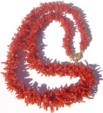 Red coral is a collection of hundreds of tiny animals living together in a colonies that resemble small leafless bushes growing on dark, rocky sea bottoms. The arms of red coral, like other branching corals, move with the tides and currents to collect microscopic plankton upon which they feed. Most of it is harvested in the deep waters of the Mediterranean and identified throughout history with Italian workmanship. It is also found in the Gulf of Naples near Genoa and off Algiers, and Tunis on the African side. It is also brought up from the waters of Sardinia, Corsica, Catalonia and Provence, as well as along parts of the French and the Spanish seaboard. There has been a coral trade between Naples, Italy, and Marseille, France, for thousands of years. The available coral is now so deep, most of it is harvested using diving robots. A pretty pink colored coral is referred to as Angel Skin, and it is also very valuable, almost as prized as the oxblood.
Red coral is a collection of hundreds of tiny animals living together in a colonies that resemble small leafless bushes growing on dark, rocky sea bottoms. The arms of red coral, like other branching corals, move with the tides and currents to collect microscopic plankton upon which they feed. Most of it is harvested in the deep waters of the Mediterranean and identified throughout history with Italian workmanship. It is also found in the Gulf of Naples near Genoa and off Algiers, and Tunis on the African side. It is also brought up from the waters of Sardinia, Corsica, Catalonia and Provence, as well as along parts of the French and the Spanish seaboard. There has been a coral trade between Naples, Italy, and Marseille, France, for thousands of years. The available coral is now so deep, most of it is harvested using diving robots. A pretty pink colored coral is referred to as Angel Skin, and it is also very valuable, almost as prized as the oxblood.
Coral Comes in Many Colors
 Many of our customers say they didn't even know there were so many different types and colors of corals. Did you know it occurs naturally in lavender, purple, black, blue, white, and of course every spectrum of red. Many people have never seen real Apple or Tiger coral. Go to Types of Coral for a more in depth look at the different types and colors of coral used in jewelry making.
Many of our customers say they didn't even know there were so many different types and colors of corals. Did you know it occurs naturally in lavender, purple, black, blue, white, and of course every spectrum of red. Many people have never seen real Apple or Tiger coral. Go to Types of Coral for a more in depth look at the different types and colors of coral used in jewelry making.
Coral & Native Americans
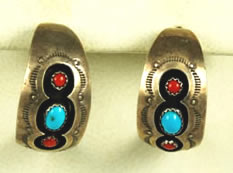 When Europeans arrived in the New World, they brought with them "blood coral" from the waters of Spain and Italy. The dark red coral quickly became a favorite of the Native Americans and was incorporated into many of their designs. Coral is often called "red gold" by some artists and symbolizes success and social prominence.
Santo Domingo peoples first used coral beads in necklaces, as wampum (trade beads). The Hopi and Zuni strung coral beads alternating with other beads such as jet, turquoise and spiny oyster for dances and ceremonies. Later the Navajo began cutting coral to inlay in their beautiful silver designs on rings, bracelets, pendants, buckles, bolos etc... See more examples of Native American Jewelry with Coral in our section on Coral Jewelry.
When Europeans arrived in the New World, they brought with them "blood coral" from the waters of Spain and Italy. The dark red coral quickly became a favorite of the Native Americans and was incorporated into many of their designs. Coral is often called "red gold" by some artists and symbolizes success and social prominence.
Santo Domingo peoples first used coral beads in necklaces, as wampum (trade beads). The Hopi and Zuni strung coral beads alternating with other beads such as jet, turquoise and spiny oyster for dances and ceremonies. Later the Navajo began cutting coral to inlay in their beautiful silver designs on rings, bracelets, pendants, buckles, bolos etc... See more examples of Native American Jewelry with Coral in our section on Coral Jewelry.
